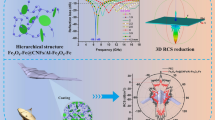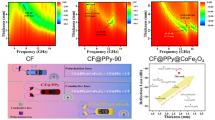Abstract
We have studied the electromagnetic interaction of gain-assisted core–shell nanostructures inside the perovskite environment. The electrostatic model has been developed to modify the dielectric constant of core–shell nanogeometries at nanolevel and studied their impact on the scattering and absorption cross section magnitude. The modification in the shell which is silica has been done by encapsulation of gain media. In core–shell geometry, silver and gold metals were used as core material and silica is used as a shell and gain is introduced into the shell. We have compared the optical cross section of the core–shell nanosphere with and without gain media, and it was observed that the introduction of gain media into the silica layer significantly enhanced the magnitude scattering cross section. This proposed work clearly suggests designing the spacer layer which is a prominent part to fabricate thin-film devices. We have also studied and compared the role of the elliptic core and spherical shell over the spherical core and spherical shell. The investigation of the quality factor (QF) of plasmon resonances under the influence of gain media has also been done and observed that the silver elliptic core and gain-assisted silica shell have the highest QF value.






Similar content being viewed by others
References
Brongersma ML, Halas NJ, Nordlander P (2015) Plasmon-induced hot carrier science and technology. Nat Nanotechnol 10:25–34
Atwater HA, Polman A (2010) Plasmonics for improved photovoltaic devices. Nat Mater 9:205–213
Leenheer AJ, Narang P, Lewis NS, Atwater HA (2014) Solar energy conversion via hot electron internal photoemission in metallic nanostructures: Efficiency estimates. J Appl Phys 115, 134301
White TP, Catchpole KR (2012) Plasmon-enhanced internal photoemission for photovoltaics: theoretical efficiency limits. Appl Phys Lett 101:073905
Narang P, Sundararaman R, Atwater HA (2016) Plasmonic hot carrier dynamics in solid-state and chemical systems for energy conversion. Nanophotonics 5:96–111
Ji A, Sharma R, Pathak H, Pathak NK, Sharma RP (2015) Numerical simulation of plasmonic light trapping in thin-film Si solar cells: surface coverage effect. J Phys D Appl Phys 48:75101–275107
Schlather AE, Large N, Urban AS, Halas NJ, Nordlander P (2013) Near-field mediated plexcitonic coupling and giant Rabi splitting in individual metallic dimers. Nano Lett 13:3281–3286
Kedia A, Kumar PS (2013) Controlled reshaping and plasmon tuning mechanism of gold nanostars. J Mater Chem C 1:4540–449
Uetsuki K, Verma P, Nordlander P, Kawata S (2012) Tunable plasmon resonances in a metallic nanotip–film system. Nanoscale 4:5931–5935
Green MA (2004) Recent developments in photovoltaics. Sol Energy 76:3–8
Lim WX, Han S, Gupta M, MacDonald KF, Singh R (2017) Near-infrared linewidth narrowing in plasmonic Fano-resonant metamaterials via tuning of multipole contributions. Appl Phys Lett 111, 061104
Portela A, Yano TA, Santschi CH, Martin OJF, Tabata H, Hara M (2017) J Biophotonics 10:294–302
Suárez G, Santschi C, Plateel G, Martin OJF, Riediker M (2014) Absorbance enhancement in microplate wells for improved-sensitivity biosensors. Biosens Bioelectron 56:198–203
Butet J, Lovera A, Martin OJF (2013) Detecting the trapping of small metal nanoparticles in the gap of nanoantennas with optical second harmonic generation. Opt Express 21, 27810
Stec GJ, Lauchner A, Cui Y, Nordlander P, Halas NJ (2017) Multicolor electrochromic devices based on molecular plasmonics. ACS Nano 11:3254–3261
Siegfried T, Ekinci Y, Martin OJF, Sigg H (2013) Gap plasmons and near-field enhancement in closely packed sub-10 nm gap resonators. Nano Lett 13:5449–5453
Noguez C (2007) Surface plasmons on metal nanoparticles: the influence of shape and physical environment. J Phys Chem C 111:3806–3819
Pathak NK, Sharma RP (2016) Study of broadband tunable properties of surface plasmon resonances of noble metal nanoparticles using Mie scattering theory: plasmonic perovskite interaction. Plasmonics 11:713–719
Raziman TV, Martin OF (2013) Polarisation charges and scattering behaviour of realistically rounded plasmonic nanostructures. Opt Express 21:21500–21507
Kristensen A, Yang JKW, Bozhevolnyi SI, Link S, Nordlander P, Halas NJ, Mortensen NA (2016) Plasmonic colour generation. Nat Rev Mater 2, 16088
Pandey GK, Pathak NK, Uma R, Sharma RP (2017) Electromagnetic study of surface enhanced Raman scattering of biomolecule: An interaction between nanodimer and biomolecule. Solid State Commun 47:255–256
Kelly KL, Coronado E, Zhou LL, Schatz GC (2003) The optical properties of metal nanoparticles: The influence of size, shape, and dielectric environment. J Phys Chem B 107:668–677
Oulton RF (2012) Plasmonics: Loss and gain. Nat Photonics 6:219–221
Premaratne M, Agrawal GP (2011) Light propagation in gain media: optical amplifier. Cambridge University Press, Cambridge
Palik ED (1985) Handbook of optical constants of solids. Academic, Orlando
Pathak NK, Ji A, Sharma RP (2014) Tunable properties of surface plasmon resonances: the influence of core–shell thickness and dielectric environment. Plasmonics 9:651–657
Park NG (2013) Organometal perovskite light absorbers toward a 20% efficiency low-cost solid-state mesoscopic solar cell. J Phys Chem Lett 4:2423–2429
Snaith HJ (2013) Perovskites: the emergence of a new era for low-cost, high-efficiency solar cells. J Phys Chem Lett 4:3623–3630
Pathak NK, Chander N, Komarala VK, Sharma RP (2017) Plasmonic perovskite solar cells utilizing Au@SiO2 core-shell nanoparticles. Plasmonics 12:237–244
Bohren CF, Huffman DR (1998) Absorption and scattering of light by small particles. Wiley, New York
Maier SA (2007) Plasmonics: fundamentals and applications. Springer, Berlin
Mokkapati S, Catchpole KR (2012) Nanophotonic light trapping in solar cells. J Appl Phys 112:101101
Kreibig U, Vollmer M (1995) Optical properties of metal clusters. Springer, Berlin
Pathak NK, Ji A, Sharma RP (2014) Study of efficiency enhancement in layered geometry of excitonic-plasmonic solar cell. Appl Phys A 115:1445–1450
Pathak NK, Pandey GK, Ji A, Sharma RP (2015) Study of light extinction and surface plasmon resonances of metal nanocluster: a comparison between coated and non-coated nanogeometry. Plasmonic 10:1597–1606
Funding
This work is financially supported by the Science and Engineering Research Board (SERB) with File No PDF/2016/000161, Government of India.
Author information
Authors and Affiliations
Corresponding author
Rights and permissions
About this article
Cite this article
Pathak, N.K., Senthil Kumar, P. & Sharma, R.P. Study of Optical Cross Section of Anisotropic Core–Shell Nanostructure Inside a Perovskite Environment: the Influence of Gain Media. Plasmonics 14, 63–70 (2019). https://doi.org/10.1007/s11468-018-0778-3
Received:
Accepted:
Published:
Issue Date:
DOI: https://doi.org/10.1007/s11468-018-0778-3




